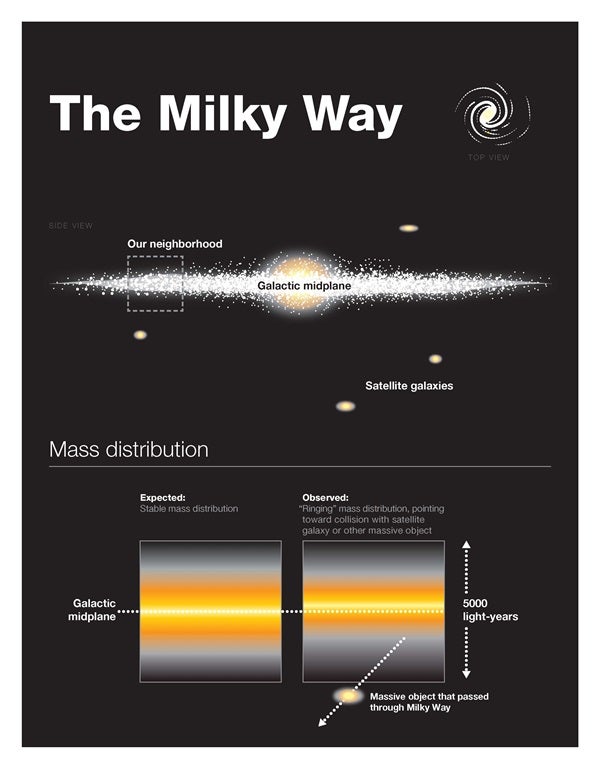“We have found evidence that our Milky Way had an encounter with a small galaxy or massive dark matter structure perhaps as recently as 100 million years ago,” said Larry Widrow from Queen’s University in Canada. “We clearly observe unexpected differences in the Milky Way’s stellar distribution above and below the galaxy’s midplane that have the appearance of a vertical wave — something that nobody has seen before.”
The discovery is based on observations of some 300,000 nearby Milky Way stars by the Sloan Digital Sky Survey (SDSS). Stars in the disk of the Milky Way move up and down at a speed of about 12–19 miles (20–30 kilometers) per second while orbiting the center of the galaxy at a brisk 137 miles (220 km) per second. Widrow and his four collaborators from the University of Kentucky, the University of Chicago, and Fermi National Accelerator Laboratory have found that the positions and motions of these nearby stars weren’t quite as regular as previously thought.
“Our part of the Milky Way is ringing like a bell,” said Brian Yanny of the Department of Energy’s Fermilab. “But we have not been able to identify the celestial object that passed through the Milky Way. It could have been one of the small satellite galaxies that moves around the center of our galaxy or an invisible structure such as a dark matter halo.”
“The perturbation need not have been a single isolated event in the past, and it may even be ongoing,” said Susan Gardner from the University of Kentucky in Lexington. “Additional observations may well clarify its origin.”
When the collaboration started analyzing the SDSS data on the Milky Way, they noticed a small but statistically significant difference in the distribution of stars north and south of the Milky Way’s midplane. For more than a year, the team members explored various explanations of this north-south asymmetry, such as the effect of interstellar dust on distance determinations and the way the stars surveyed were selected. When those attempts failed, they began to explore the alternative explanation that the data was telling them something about recent events in the history of the galaxy.
The scientists used computer simulations to explore what would happen if a satellite galaxy or dark matter structure passed through the disk of the Milky Way. The simulations indicate that over the next 100 million years or so, our galaxy will “stop ringing” — the north-south asymmetry will disappear and the vertical motions of stars in the solar neighborhood will revert back to their equilibrium orbits — unless we get hit again.
The Milky Way is more than 9 billion years old with about 100 billion stars and total mass more than 300 billion times that of the Sun. Most of the mass in and around the Milky Way is in the form of dark matter.
Scientists know of more than 20 visible satellite galaxies that circle the center of the Milky Way, with masses ranging from 1 million to 1 billion solar masses. There may also be invisible satellites made of dark matter. (There is six times as much dark matter in the universe as ordinary, visible matter.) Astronomers’ computer simulations have found that this invisible matter formed hundreds of massive structures that move around our Milky Way.
Because of their abundance, these dark matter satellites are more likely than the visible satellite galaxies to cut through the Milky Way’s midplane and cause vertical waves.
“Future astronomical programs, such as the space-based Gaia mission, will be able to map out the vertical perturbations in our galaxy in unprecedented detail,” Widrow said. “That will offer a strong test of our findings.”










